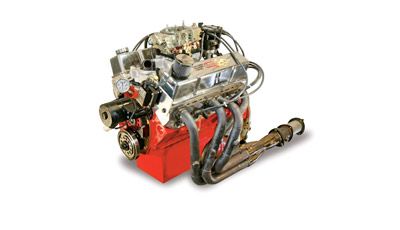
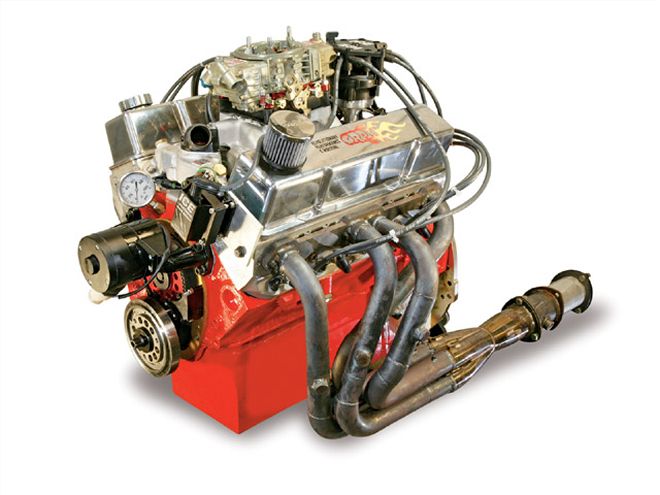 Smaller engines like this 327 small-block Chevy (now bored out to 337 ci) are more economical, but are usually down on power. Not this one: the author managed 529 hp at a street-friendly 6,500 rpm.
Smaller engines like this 327 small-block Chevy (now bored out to 337 ci) are more economical, but are usually down on power. Not this one: the author managed 529 hp at a street-friendly 6,500 rpm.
Orlando, Florida, is home to one of the most iconic and recognized destinations on the planet: Disneyworld. But not all travelers venture south in the dead of winter to visit Tomorrowland or the Epcot Center. Just after Thanksgiving each year, those of us fortunate enough head to Orlando for a different E-ticket ride. We go there for the Performance Racing Industry trade show, or PRI for short. It was at this convention in December 2007 that our small-cube small-block project was born. In a side room, a group of interested parties, myself included, joined together to hear our friend, Ed Zinke, announce that the rules for the 2008 Engine Masters Challenge had been finalized. We immediately tore into the rulebook, eagerly looking at changes and building mental images of the combinations that we thought would rule the world. Me and my crew from Revolutionary Performance and Machine spent countless hours contemplating how we could make big power and torque with a 10.5:1 flat-tappet engine. We had to break it down to the basics, and go from there.
The trick to going fast and performing well at the EMC is to make tons of torque, and spread it out over a wide rpm range. As horsepower is literally just a mathematical function of torque and rpm, and cannot be measured, it should make sense that we focus on torque here. So then the keys to making that torque were to induce as much air/fuel mixture into the combustion chamber as possible-across the whole rpm range-trap and Compress that mixture, and light it off just in time to take full advantage of the expanding flame front. It sounds like a very basic explanation, and it is. Sure, there are other factors, like reducing friction and thermal efficiency, etc., but in the end, it all boils down to the induction system.
At the previously noted PRI show, we ran into Rick Sperling of Air Flow Research (AFR), and spoke with him at length about his cylinder heads. Having decided to build a .060-over 327 (actually 337 cubic inches), we thought it might be easier to start with a relatively large runner cylinder head, and shrink it down to a usable size, rather than porting a small head. AFR's ace head designer, Tony Mamo, recently redesigned the 210 Eliminator heads, and included a swirl-inducing wing on the back side of the intake guide. I had seen these designs on several race heads, but had yet to see whether it would help or hinder the performance of the engine, so I ordered a set of the Competition-ported heads, and we had our first seed part.
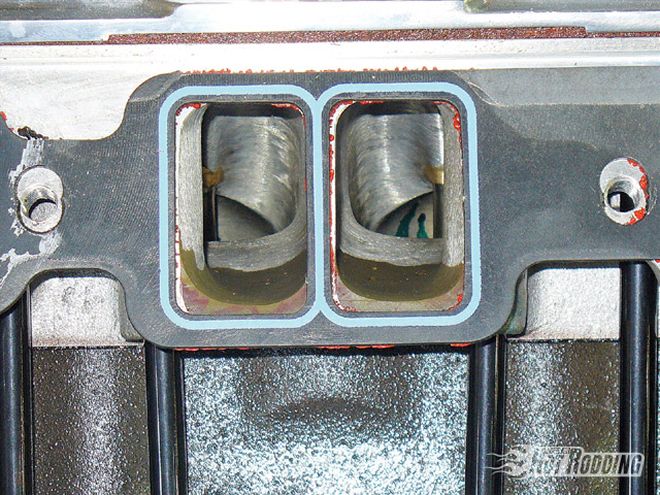 The business end of the intake runner for our 327 small-block is reduced to just under the size of a Fel-Pro 1205 gasket. Adding epoxy to the floor has the added benefit of making the head an artificially raised-runner design.
The business end of the intake runner for our 327 small-block is reduced to just under the size of a Fel-Pro 1205 gasket. Adding epoxy to the floor has the added benefit of making the head an artificially raised-runner design.
We dissected the heads as soon as they arrived at our doorstep, and were quite pleased with the new design features. Lightweight 8mm-stem valves were a clear break from the previous tradition of using 11/32-inch stems in small-block heads. The reduced reciprocating mass of the valves allowed us to use a lower spring pressure than we would normally have to. This would keep the valves in control with the extremely aggressive cam lobes we had in our plans. Naturally, we put the heads on the flow bench to see how they performed in out-of-the-box condition. They put up good numbers on our Superflow SF600 flow bench, peaking at 287 cfm on the intake, and 225 cfm on the exhaust (without a pipe) at .700 lift. Knowing that the advertised numbers were slightly higher than what we saw, we did a quick cartridge roll cleanup of the runners, and saw an immediate increase to 307-cfm intake, and 227-cfm exhaust. This increase is more than likely due to the removal of a small parting line on the short-side radius commonly created on CNC-ported heads where the cutting tool changes from cutting down through the valve side of the head, over to the runner entry side of the head. Newer versions of the heads are said to have greatly reduced these transition lines. The intake runners actually measured a hair less than the 210cc advertised volume, but with a mere 337 cubic inches to feed, we felt that making the runners smaller would aid in increasing the port velocity and getting the runners working sooner in the rpm range. Globs of Splash Zone marine epoxy (aka green death-wear a respirator when porting!), properly shaped and finished, reduced the runner volume to 203 cc without dropping a single cfm below our target .650 lift. The legendary Edelbrock Performer RPM intake manifold was given the same treatment in a mirror image with the runners gradually tapering to the as-cast sizing at the runner entries.
To take full advantage of the large airflow potential when running this small-cube engine, we consulted with Chris Mays at Comp Cams, who ground us a couple of small-duration solid flat-tappet cams to try with the most aggressive opening rates possible for a Chevy lifter. We were initially pleased with the first cam, a 236/242-at-.050 grind; however, I spent some time with a degree wheel and a dial indicator and realized that I could get the same intake valve seat-to-seat time, but with more duration everywhere else if I ran a 242/242-at-.050 cam, but opened up the lash on the intake. Dyno testing confirmed my theory, and we were rewarded with a 7-12 ft-lb gain in torque across the board. Opening the exhaust lash increased power as well, indicating either the exhaust lobe had too much duration, not an aggressive enough ramp rate, or both.
In situations where we are building an engine with an extremely aggressive cam, it is imperative to make sure the lifters are properly positioned, and will survive the punishment given to them, so we had the block Lifter-Trued by our friends at Shacklett Machine in Nashville, Tennessee, and Comp Cams was able to use their recently added nitriding process to treat our cam and lifters. Even with those precautionary steps, we broke the cams in without the inner valvesprings before switching to the Royal Purple racing oil, and testing on the dyno at full load.
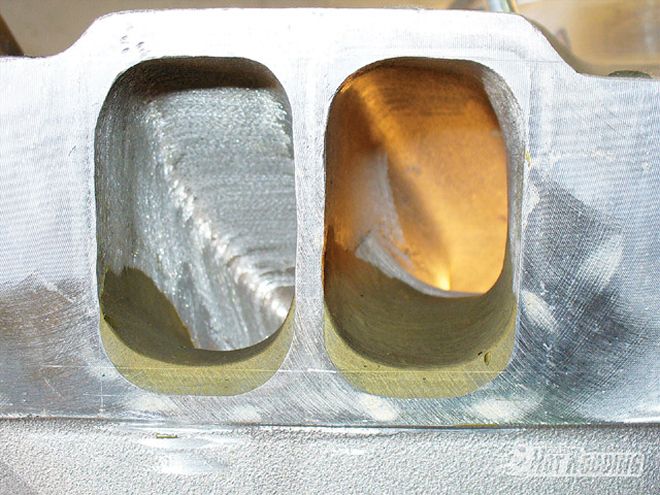 The intake manifold runners were given the same treatment as the heads. The runners were tapered from as-cast, down to the 1205 gasket size, increasing port velocity and efficiency.
The intake manifold runners were given the same treatment as the heads. The runners were tapered from as-cast, down to the 1205 gasket size, increasing port velocity and efficiency.
With the induction and valvetrain systems in good shape, we didn't want to neglect the bottom end of our mini-mouse. Our good friend Kris Henderson donated a vintage '67 327 block and factory steel crank to the cause. Knowing that we would have a tough time keeping our cam alive, I placed the block upside down in our mill and drilled .059-inch-diameter holes in the main oil galley above each of the cam lobes to spray oil directly on them. We then built sheetmetal trays and fitted them under the cam, so the excess oil would not pour directly on the crank to create excess windage losses. Restrictors in the lifter galleys kept the majority of oil focused on the cam squirters and main and rod bearings, instead of shoving it all to the top end where a high volume is not required. Adding up the areas of the camshaft oil squirters basically put an almost 3/4-inch hole in our oil system. Even with conservative oil bearing clearances helping us out, we were idling with a mere 7-9 psi of oil pressure, and maxing out at 40 psi. In the future, dropping the squirter size to a more reasonable .020-inch would increase pressure significantly, and make the design feasible in a street car. As a method of easily keeping track of running oil pressure, as well as satisfying our curiosity, we measured oil pressure at the standard location on the rear of the block as well as the front of the main oil galley, and found almost a 10-psi drop. This lead to future plans to check oil pressure at the end of the lifter galleys as well.
Once the block was machined, we spent several hours with a rock grinder reshaping the GM crank before chucking it up in the lathe and turning down the counterweights. This acComplished two tasks: First, we were able to reduce air friction through bullnosing the front edge and knife edging the trailing end of the crank. Second, removing mass from further out on the counterweights and concentrating it more toward the center allows the crankshaft to rev quicker. Some dynos may not record improvements in inertia as increased power, but testing on the DTS dyno, as the EMC is contested on, definitely showed a real-world improvement that would be seen at any race track.
Swinging on the rod journals was a set of Eagle Specialties Superlight connecting rods with ARP 2000 bolts keeping the caps securely in place. In line with our plans to reduce rotating and reciprocating mass, we pressed out the factory wrist pin bushings, machined a set for flyweight .866-inch-diameter wrist pins, pressed them in, and honed them to fit. Ross made sure the custom pistons they designed would work with the combination, and they were sealed up with Total Seal gapless rings.
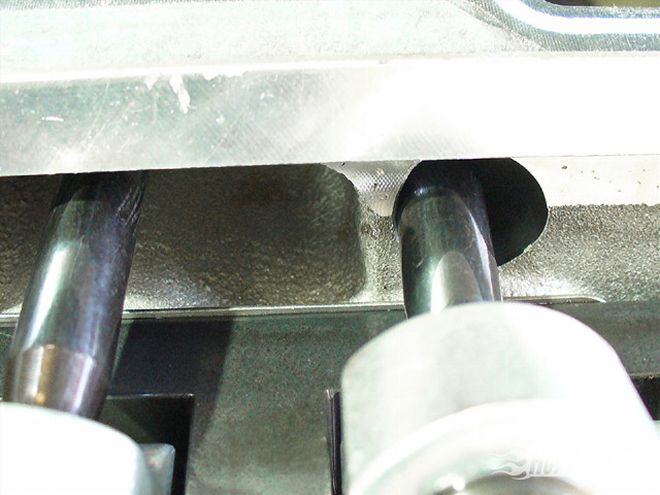 Using big pushrods has consequences. We had to clearance the pushrod holes so there was no interference there. A minimum of .010 inch is recommended, as the head can act as a sort of second pushrod guide, and anything more than that is wasted time with a grinder.
Using big pushrods has consequences. We had to clearance the pushrod holes so there was no interference there. A minimum of .010 inch is recommended, as the head can act as a sort of second pushrod guide, and anything more than that is wasted time with a grinder.
Rules changes for the '08 EMC restricted the dimensions of the oil pan to no wider than the factory pan rails, and no deeper than 12 inches from the crank centerline. Taking advantage anywhere we could, we called up Kevco Oil Pans and had them make us a piece within those specs. It included a windage screen as well as a baffle underneath it. A crank scraper was also quickly fabbed up to help out. The pan housed a Melling M-Select high-volume oil pump that we put to the test.
Once the bulk of the engine was laid out, a significant portion of our time was spent tuning it to wring out whatever we could from the little mouse. Patrick at Pro Systems carburetors built us a 4150-style carb that was as pretty as it was functional. It responded well to jet and air bleed changes in a manner that was predictable and repeatable. Not all carbs share that trait. The carb used annular boosters that tend to reduce total airflow, but increase response and fuel atomization at lower rpm. The carb was perched atop a Comp Cams phenolic 1-inch open carb spacer. The phenolic plastic reduces heat transfer from the intake to the carb, and is lightweight to boot.
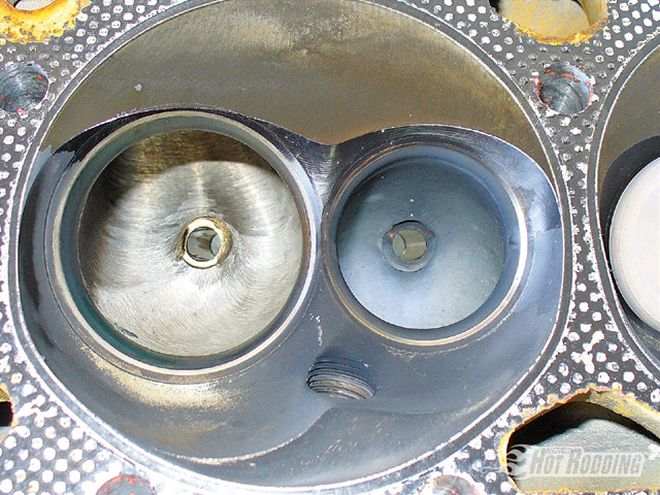 Beneath the head of the intake valve, AFR designed a wing to promote swirl as the air/fuel mixture enters the chamber. Once trapped and Compressed, the efficient chamber design helped the little engine harness the burning fuel without wasting energy. This AFR design feature is one we'll also revisit for the 408ci we're building for Project Talladega, our '75 Laguna.
Beneath the head of the intake valve, AFR designed a wing to promote swirl as the air/fuel mixture enters the chamber. Once trapped and Compressed, the efficient chamber design helped the little engine harness the burning fuel without wasting energy. This AFR design feature is one we'll also revisit for the 408ci we're building for Project Talladega, our '75 Laguna.
We were able to adjust cam timing with our Comp Cams beltdrive. Not nearly as expensive as you might think, this was an extremely valuable tuning tool. We were able to move our cam as much as 8 degrees advanced before the power output started to decline. We ended up backing up the cam to 7 degrees, and it was probably a good choice as there were witness marks on each of the pistons from the intake valves kissing them! Probably the most common time in a tight-tolerance race engine's life to expire is at the top end of the track or dyno pull, just as the throttle is slammed shut and the engine decelerates rapidly. This creates a scenario where the rpm is still peaked, but instead of the piston being under load from compression or exhaust as it approaches TDC, the load is suddenly removed and the piston is allowed to travel farther towards the cylinder head and with a greater G-force, due to the lack of opposing pressure. Most timing chains have more slack than a beltdrive, allowing the cam to advance during this deceleration. This "extra" advance, coupled with the piston being closer to the head, greatly increases the chances of a piston-to-intake-valve collision, with disastrous results. Lightweight pistons and the Comp Cams beltdrive likely prevented a catastrophic ending to our engine in testing.
With every jet and cam timing change, we maximized our ignition timing as well. Small-stroke engines like our 337 prefer a good amount of lead, and ours was happiest with 38 degrees. The ICE 10-amp setup was overkill for our pump-gas guzzler, but like ICE owner Michael Konstandinou says, "The worst that can happen is you won't lose any power. The best that can happen is that you'll gain some."
Tuning didn't end with changes to the cam, carb, and spark. We spent a good amount of time running our combination through a software program called Pipemax. It's a great simulator of engine dynamics, and we were able to use the information it gave us to build a set of headers and collectors tuned for the engine and rpm range given. Opening our three-inch collectors into the beautiful Magnaflow mufflers produced a great sound without hurting power a bit.
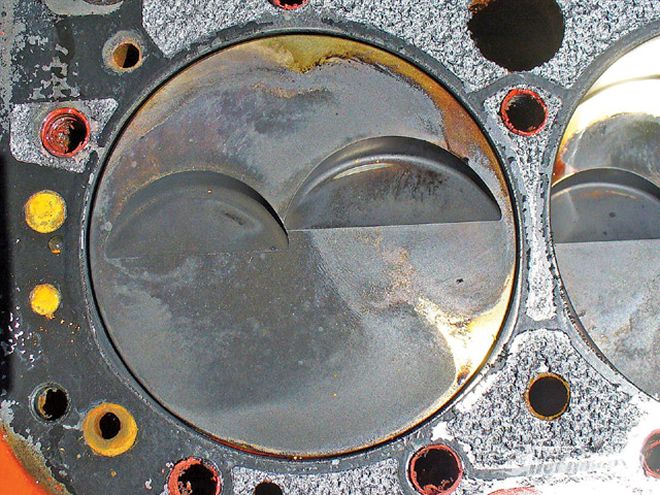 A mirror image to the chamber, the pistons show evidence that the intake guide "wing" worked as intended; however, the slight fuel tracking is an indicator that some fuel came out of suspension. A less homogonized mixture can lead to a loss in power. Only further testing without the wing will tell us for sure whether it helped or hurt. Also seen here is proof that we had advanced the cam as much as possible. Check out the self-clearanced intake valve notch!
A mirror image to the chamber, the pistons show evidence that the intake guide "wing" worked as intended; however, the slight fuel tracking is an indicator that some fuel came out of suspension. A less homogonized mixture can lead to a loss in power. Only further testing without the wing will tell us for sure whether it helped or hurt. Also seen here is proof that we had advanced the cam as much as possible. Check out the self-clearanced intake valve notch!
Once the clock struck midnight in this Cinderella story, the little Chevy twisted the dials to a whopping 529 horsepower, and 481 ft-lb of torque. Had I said last December that I knew we could make that kind of power with such a short stroke, surely my nose would have grown an inch. As it was, when the Challenge had ended and we loaded up our mini-mouse, we couldn't help but happily go whee whee whee all the way home.
Comp Cams BeltDrive: The Tuner's Advantage
Lurking behind the 327's water pump and Powerbond harmonic damper is one of the least known members of the Comp Cams family. Calling up Jegs to order PN 6100 will get you this beltdrive timing set that makes assembling and tuning a high-performance engine a breeze. Beltdrives are often thought to be reserved for ultra-high-dollar endeavors, but with a price under $500, there are few reasons not to pick one up.
The main advantage of a beltdrive is adjustability. During dyno or track testing, it takes literally just a few minutes to move the camshaft a degree or two, reset the ignition timing, and make another pull or pass. In most cases, this can be done without removing the water pump or damper-way better than having to tear down the whole front of the engine to try different cam settings.
Another great advantage of the Comp beltdrive is the ease with which you can set the camshaft endplay. Flat-tappet cams use tapers ground into the cam lobes to force the cam toward the rear of the engine; however, all hydraulic and solid-roller cams are ground with no taper in the lobes, and require some method of keeping the cam from walking back and forth. Cam buttons are typically used, but they rely on flimsy timing covers that tend to flex. The Comp beltdrive uses an adapter mounted to the front of the camshaft as well as brass shims on either side of the adapter to keep the cam consistently located. End play is easily adjusted with various shims (included).
Unlike other aftermarket timing covers, we've had zero issues with oil leaks, and nobody can dispute the added bling factor a beltdrive adds. It costs a little more, but one thing I've learned in years of building engines is that it's better to spend a few dollars up front than to waste precious time and performance down the line.
BY THE NUMBERS Revolutionary Performance & Machine 327 Small-Block Chevy Claimed Displacement: 337 ci Qualifying score: 2,403.8 Team leader: Daryl White Team members: Shannon Carnathan Hometown: Mount Juliet, TN Bore: 4.060 inch Stroke: 3.250 inch Compression ratio: 10.5:1 Carburetor: Holley 860 Carb spacer: Comp open 1-inch Intake: Edelbrock Performer RPM Cylinder heads: AFR 210cc Block: Chevy Intake valve: 2.080 inch Exhaust valve: 1.{{{600}}} inch Camshaft specs: Comp; 242/242 degrees @ .050, .655/.655-inch lift Rocker arms: T&D, 1.9:1 Crankshaft: Chevy Rods: {{{Eagle}}} Pistons: Ross Rings: Total Seal Ignition: ICE 10 amp Oil: Royal Purple, 5W-30 Headers: Gene Steele, 1 5/8-1 3/4-step Mufflers: Magnaflow 3.5-inch ON THE DYNO {{{DTS}}} DYNO DATA 337CI SMALL-BLOCK CHEVY RPM TQ HP 2,500 381 181 2,600 391 193 2,700 297 204 2,800 400 213 2,{{{900}}} 403 222 3,000 402 229 3,{{{100}}} 398 235 3,{{{200}}} 388 236 3,{{{300}}} 378 238 3,400 377 244 3,500 384 255 3,600 396 271 3,700 414 292 3,800 431 312 3,900 446 331 4,000 456 347 4,100 463 361 4,200 467 373 4,300 469 384 4,400 470 394 4,500 471 403 4,600 473 414 4,700 476 426 4,800 479 437 4,900 480 447 5,000 481 458 5,100 481 468 5,200 480 475 5,300 476 480 5,400 471 484 5,500 466 489 5,600 464 494 5,700 460 500 5,800 456 504 5,900 449 504 6,000 436 498 6,100 429 499 6,200 431 509 6,300 433 521 6,400 432 528 6,500 427 529